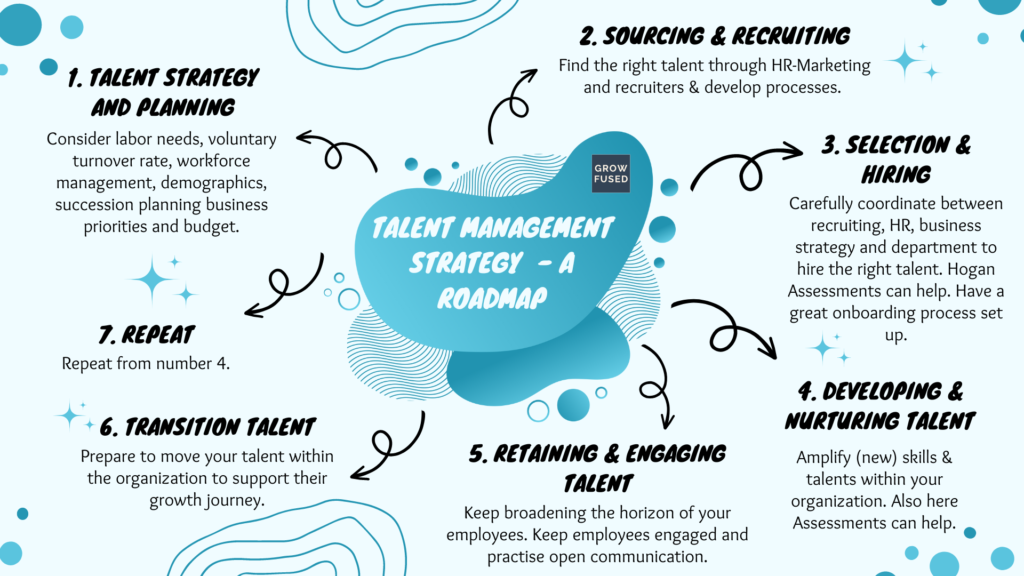In today’s tight labor market, organizations must go the extra mile to attract and retain talent. Traditionally, organizations do this by handing out financial incentives, but this has proven to be only a temporary stimulant. A robust Talent Management Strategy model that combines education with ongoing personal development has become critical and will keep employees motivated not only today but also tomorrow. It is the key to increase performance.
So what exactly is a Talent Management Strategy?
A successfully implemented Talent Management Strategy ensures an organization puts an employee’s unique talent (like expertise, qualities, and abilities) to full use. The term ‘talent’ refers to someone being exceptionally good at their work – how effortless it can be for some to complete a task that others don’t even know how to start, and the fulfillment this brings them. Talent Management is about answering the question, ‘how do we bring this out to the fullest in our people, and even better: how can we grow and expand it?’’
Why is Talent Management Strategy important?
It is a fact that when employees can constantly develop their talent, they will be happier in their work, more involved, and less likely to look for opportunities elsewhere. A successful Talent Management Strategy starts with recruiting the right employee and will remain an integral part of an employee’s journey and time within an organization.
What are the benefits of a successful Talent Management Strategy?
A Talent Management Strategy can bring an organization success in many ways: it can enable employees to work more independently, for example. Every organization has goals and targets, and applying the right Talent Management Strategy that optimizes individual employees’ talent(s) will result in better output and a higher likeliness of accomplishing these. Some say it can even be the deciding factor in making your organization more successful than your competitor.
What are the key elements of a successful Talent Management Strategy?
Invest in employees via professional training/activities
Have a high-level onboarding process
Make the entry of a new employee memorable, and make your organization stand out from the competition. Onboarding should show company culture and immerse new people from the get-go: ‘you can only make a first impression once’ as the saying goes.
Incorporate a third-party consultant
A company can often get so caught up in how they do things that it fails to notice errors and inconsistencies in its operations. It can help to incorporate an experienced consultant with the right expertise to not only help set up a Talent Management Strategy tailored to your organization but also to help set the criteria for evaluating the effectiveness of a Talent Management Strategy.
Third-party coaching is the perfect opportunity for organizations to help employees get the best out of themselves by bringing someone in with just one focus – training and supporting an employee within your organization. Consulting and Coaching happens to be what we specialize in at Growfused – so please get in touch to learn more!
Track employee performance
A well-developed Talent Management Strategy identifies, nurtures, and optimizes an employee’s qualities as they are crucial to the success of an organization. Different data from within your organization can be an excellent input source here. It can show you how your organization is performing and changing: use this data for performance reviews, personal development plans, education, etc.
Share positive feedback
Convert business goals into talent goals
Senior management often views growth as abstract goals and objectives. Implementing a Talent Management Strategy will bring the human factor to business goals because achieving business goals is done by putting employee talent to the best use.
Ensure a high-performance culture
Build an organizational culture on a set of universally accepted behaviors and encourage these through acquiring the best tools and implementing optimal ways of working. By doing this, your employees can be as effective as possible.
Provide a clear career path
A clear career path involves understanding the personal characteristics, experience, knowledge, skills, and ambition required for top performance in an employee’s career. Make known the promotions and departmental transfers that might be in reach if they perform well.
Develop mentorship/coaching inside the organization
Mentoring can help employees expand their wisdom and ability to apply their knowledge, skills, and experience in new ways. Mentorships are an excellent way for companies to demonstrate organizational commitment to empowering employees to keep levelling up.
Talent Development examples
Formal internal program
For companies with the scale and means to do so, in-house training and development plans are the way to go. These plans can be tailor-made for each employee within a framework. Some examples are training aimed at developing specific technical skills and abilities or preparing future management for leading and managing teams, groups, and workforces.
Mentorship opportunities
One-to-one mentorship can be an excellent accelerator for developing talent. Assigning a mentor to an employee can significantly enhance skills. Successful mentors come from different areas. A perfect opportunity for organizations to create unique mentor-mentee relationships!
Individualized growth
Organizations wanting to empower and support the employees with the highest potential and talent can set bespoke, achievable targets in an Individualized Growth Plan. This plan considers the employee’s strengths, weaknesses, and future ambitions.
Partnerships with external providers
There are many ways to optimize the Talent Development Plan. A very effective one is working with external providers: online, in-person, or hybrid training programs often provide a level of learning that simply can’t be delivered internally. Of course, External Talent Development Plans can also be part of Formal Internal Programs!
Talent Management Strategy Success - Best Practices
Every organization has its own goals and targets that make them unique. These goals must be clear and achievable to ensure an employee can meet them. They also need to be measured to determine whether a Talent Management Strategy is working (or not).
Here’s how:
- Identify an employee’s unique talent(s) – by having discussions and using tools and data such as Hogan Assessments, 360 degree Feedback.
- Involve an employee by valuing their input: Is there a hidden talent an employee would like to bring out or develop more? Is there a specific role they are keen to fulfill?
- Employees that put their talent to full use can be triggered to find new and other skills they can bring to the table.
Talent Management Strategy - A Roadmap
The process of strategy implementation will typically look like this:
1. Talent Strategy and Planning
What are the goals for the company going forward, and what talent do we need to attract to get to these goals? What profiles should the ideal candidates have? Where do we find this talent?
The roadmap to a successful Talent Management Strategy starts with a clear plan, often by bringing together people from different departments and disciplines to get a clear overview of where a company needs to be going.
2. Sourcing and Recruiting
Find the right talent. When the Talent Strategy Plan is in place, it will be much easier to work with internal and external recruiters to find suitable candidates.
3. Selection and hiring
With a Talent Management Strategy in place, what hires are needed will become more evident. It will also be easier for recruiters to vocalize an organization’s needs to a candidate, creating a much more effective recruiting process.
4. Developing & nurturing talent
Make individual Talent Management Strategies that will amplify (new) skills & talent. For example, excellent abilities in Hard Skills don’t automatically mean exceptional abilities in Soft Skills, and vice-versa.
5. Retaining and engaging talent
Keep broadening the horizon, developing current skills, and exploring new ones. Keep employees challenged! Following these guidelines will create an environment where talented employees will have no reason to leave the organization.
6. Transitioning talent
Suppose the Talent Management Strategy is doing well. In that case, it can happen for employees to want to move into different areas within the organization, expanding on their strengths and resulting in more added value.
7. Repeat from number 4
Conclusion
The risks of not having a solid Talent Management Strategy are becoming more evident daily. If you read in the news about employees leaving an organization by the dozens, chances are high that their Talent Management Strategy isn’t doing very well!
Developing a Talent Management Strategy and implementing it is an ongoing, ever-evolving process. It includes recruiting, training, supporting, and compensating your employees as they create value for your company. Much of the talent management strategy lies with the HR department, but other people within your company also need to be involved. If done right, everybody benefits.
Does your organization (or the organization you work for) have its Talent Management Strategy in place?
Subscribe To Our Newsletter
Consider subscribing if you don’t want to miss out on amazing offers and when new posts go up!!

